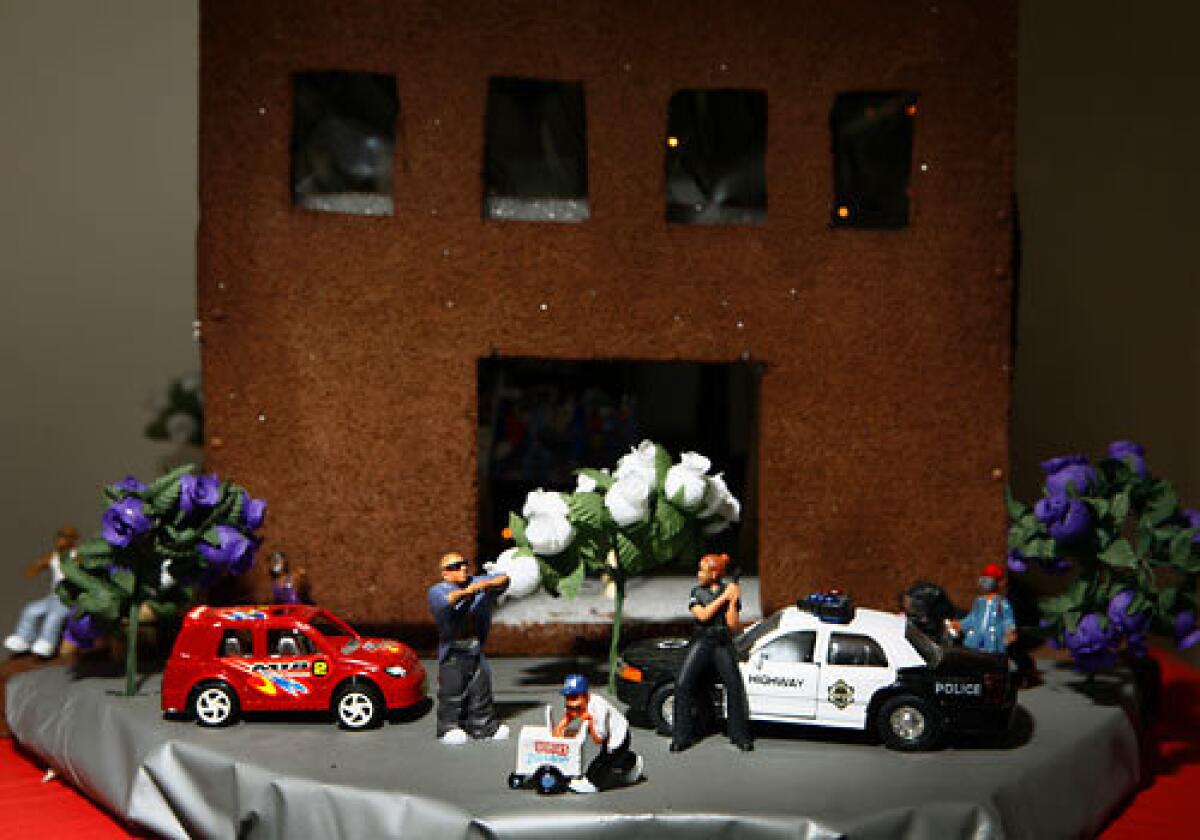‘Skid Row History Museum’

TALKING WITH John Malpede, co-curator of a new show at Chinatown’s Box Gallery, about the complex contours of life on skid row, you might start to wonder: Is the work meant to be more educational or aesthetic?
Malpede isn’t saying. “It’s our job as artists to confuse the categories,” he states.
However you see it, the multimedia exhibition “Skid Row History Museum,” opening Saturday, will fill three rooms with about 80 photographs, videos, a large-scale floor map of skid row, much signage, a couple of shopping carts, a cardboard hotel, a tent and a workshop space in which viewers can offer thoughts and suggestions. The majority of images and materials are taken from the archives of the Los Angeles Poverty Department, a multidisciplinary performance troupe founded by Malpede to explore the social forces creating poverty.
The show will spill out onto Chung King Road, re-creating a “sleeping zone” such as the ones once dreamed up by city officials. “In 1997, [City Hall] designated sleeping zones by hanging signs and taping off certain areas in which it was legal to sleep,” Malpede says. “It was another manifestation of a lack of policy agenda.”
But the show is not only meant to critique. “We want to celebrate the good things as well as the boneheaded moves,” he says. “It’s sad that some real solutions have been downplayed. People have had a lot of good ideas, and some public policy has made things better.”
Intentionally playful in their “museum” approach, curators Malpede and Box Gallery director Mara McCarthy nevertheless take their roles as documentarians seriously. A few of the featured videos are what they call “ambient” -- projections of a simmering pot of beans or a real-time street scene designed to capture a sense of place. But by and large, the show will be dominated by images of the people of skid row -- specifically, members of the community identified by their neighbors as significantly positive contributors.
“It’s a whole wall of people living or working in skid row or skid row-adjacent who don’t fit the negative profile,” Malpede says of one portion of the exhibition.
Another wall will be devoted to a controversial bit of municipal code called 41.18(d), which is designed to prevent people from sitting, lying or sleeping on city streets, save for at parades.
In between these walls will sit a stylized 11-foot-square map of downtown’s homeless core, rendered in black vinyl and meant to illustrate the encroaching development pressures squeezing in on the homeless community. Colored tape will physically draw connections between the people featured and their neighborhood locations. “It’s totally art, totally history and totally the future,” Malpede says.
In a nod to that future, the troupe worked with graphic designer Roman Jaster to develop prototypes of tributary plaques for what Malpede calls a skid row alternative to the Hollywood Walk of Fame.
In fact, they’ve already been in talks with city agencies about using the Box exhibit as a study for that larger project, he says, and the workshop space will focus on gathering audience input for its design. “That’s one of the main impetuses for this whole thing,” Malpede says.
It’s also the sort of idea that fits neatly into McCarthy’s reason for creating her gallery. The Box has planned a full schedule of events related to the show, featuring informal talks, monologues, poetry and music, including at least one gospel choir, all performed by people who live or work in the skid row area.
“I’ve never used the word ‘civic,’ but I really want to bring education and discussion and ideas back to the gallery space,” McCarthy says. “Not just hang a show that people come in, look at, have a drink and that’s it. I like the idea of a whole group of artists mixing with skid row residents and activists.”
‘SKID ROW HISTORY MUSEUM’ WHERE: The Box Gallery, 977 Chung King Road, downtown L.A.WHEN: 6-9 p.m. Sat. Ends Aug. 2. Check website for full list of events.PRICE: FreeINFO: (213) 625-1747, theboxla.com
More to Read
Start your day right
Sign up for Essential California for news, features and recommendations from the L.A. Times and beyond in your inbox six days a week.
You may occasionally receive promotional content from the Los Angeles Times.






